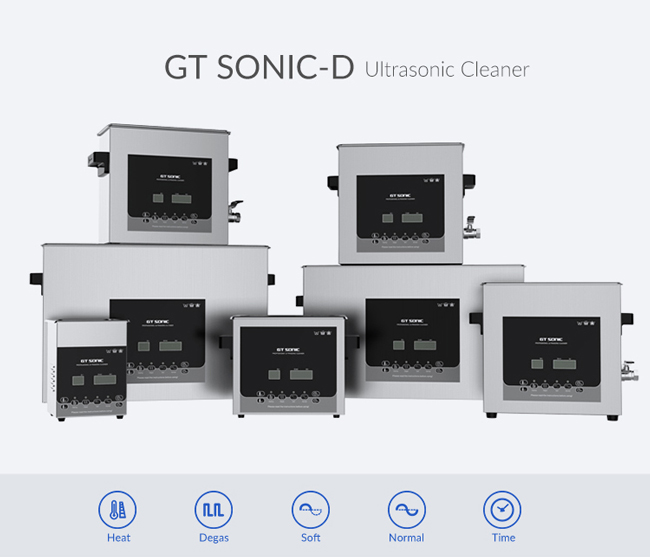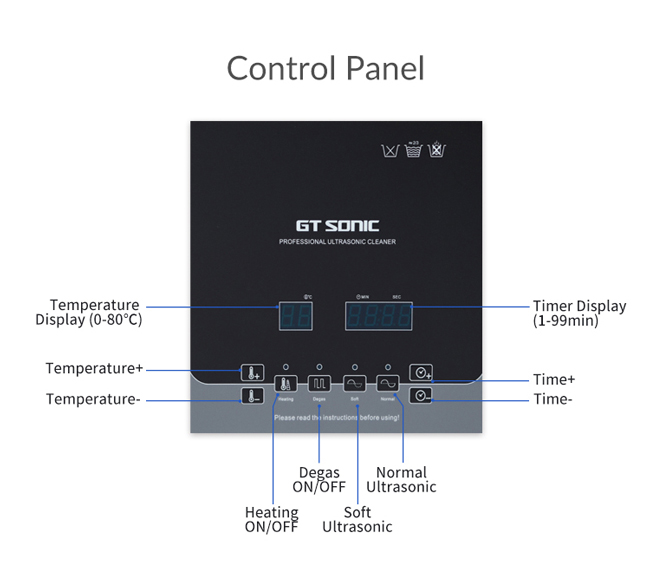What Is Degas Ultrasonic Cleaner
2025-08-21
Ultrasonic cleaners have revolutionized precision cleaning in laboratories, medical facilities, and manufacturing plants by harnessing high-frequency sound waves to generate microscopic cavitation bubbles
What Is Degas Ultrasonic Cleaner?
Ultrasonic cleaners have revolutionized precision cleaning in laboratories, medical facilities, and manufacturing plants by harnessing high-frequency sound waves to generate microscopic cavitation bubbles that scrub away contaminants. However, to maximize cleaning performance and achieve consistent results, most users rely on the degas function of ultrasonic cleaner tanks.
Key takeaways
| What is degas in ultrasonic cleaner? |
| Why degas ultrasonic cleaner matters |
| How the degas function on ultrasonic cleaner works |
| Ultrasonic degas mode vs. cleaning mode |
| How long to degas ultrasonic cleaner |
| How to degas an ultrasonic cleaner (step-by-step) |
| Advanced considerations |
| Troubleshooting degas ultrasonic cleaning |
By the end, you’ll have a crystal-clear understanding of what does degas mean in ultrasonic cleaner, what is the degas function on an ultrasonic cleaner, and the best practices for harnessing the ultrasonic degas function to achieve optimum cleaning results.

Introduction to Degassing in Ultrasonic Cleaning
A degas ultrasonic cleaner features a dedicated cycle or mode designed to strip dissolved gases—primarily air—from the cleaning solution before the actual cleaning run. This degas function on ultrasonic cleaner ensures that cavitation bubbles form uniformly and collapse with maximum force, yielding consistent cleaning across the entire tank.
Without proper degas, air bubbles interfere with cavitation, creating “dead zones” and reducing cleaning efficacy. Ultrasonic degas function is especially critical when:
-
Cleaning delicate or precision parts (e.g., lenses, surgical instruments)
-
Performing regulated processes requiring reproducibility (e.g., GLP/GMP labs)
-
Rinsing or degassing silicone-based solutions (e.g., ultrasonic bath to degas silicone)
Why Degas Ultrasonic Cleaner?
Ensuring Uniform Cavitation
-
Cavitation: The rapid formation and implosion of microscopic bubbles driven by ultrasonic waves.
-
Dead zones: Regions where air bubbles prevent proper cavitation, leading to uneven cleaning.
-
Degassing: Removes dissolved air, allowing cavitation bubbles to form on demand and collapse uniformly, maximizing scrubbing intensity.
Enhancing Cleaning Consistency
-
Batch-to-batch repeatability: Critical for regulated industries (pharma, medical devices).
-
Process validation: Degassing reduces variability, making performance easier to document (foil tests, aluminum oxide tests).
Reducing Noise and Vibration
Prolonging Equipment Life
By minimizing micro-shock from collapsing air bubbles, the degas function on an ultrasonic cleaner reduces mechanical stress, extending the lifespan of transducers, generators, and tank assemblies.
Science Behind Ultrasonic Degas Function
Dissolved Gas in Liquids
-
Liquids like water and detergents naturally dissolve atmospheric gases.
-
Temperature, pressure, and detergent chemistry influence gas solubility.
Mechanics of Degassing
-
Heat-Assisted Degassing
-
Ultrasonic-Only Degassing
-
Vacuum Degassing
-
Continuous Recirculation Degassing
Ultrasonic Degas Mode vs. General Cleaning Mode
| Feature |
Degas Mode |
General Cleaning Mode |
| Objective |
Remove dissolved gases |
Remove soils from parts |
| Power Level |
100% or pulse-mode for maximum cavitation |
30–100% depending on soil type |
| Frequency |
Typically lowest frequency (20–25 kHz) for aggressive cavitation |
Frequency optimized per part sensitivity (20–80 kHz) |
| Duration |
2–5 minutes |
3–15 minutes |
| Heating |
Optional (30–40 °C) |
Recommended for faster cleaning (up to 60 °C) |
| Solution |
Plain water or low-concentration detergent |
Full-strength cleaning solution |
How Long to Degas Ultrasonic Cleaner?
| Tank Volume |
Degas Time (Ultrasonic-Only) |
Degas Time (Vacuum-Assisted) |
| <5 L |
2 minutes |
1 minute |
| 5–20 L |
3–4 minutes |
1–2 minutes |
| >20 L |
4–5 minutes |
2–3 minutes |
How to Degas an Ultrasonic Cleaner: Step-by-Step Guide
Follow these steps to harness the degas function on ultrasonic cleaner tanks:
Preparation
-
Inspect Tank: Ensure no debris or residue from previous runs.
-
Fill with Water: Up to manufacturer’s “min/max” marks using deionized water.
Add Detergent (Optional)
-
For processes requiring mild detergents (e.g., degas ultrasonic cleaning of silicone), add at low concentration (0.5–1%).
-
Stir gently to minimize bubbles.
Initiate Degas Mode
-
Select “Degas” or “Degas Mode” on control panel.
-
Set Duration: 2–5 minutes based on tank size.
-
Set Temperature: 30–40 °C accelerates degassing.

Monitor Cavitation
Drain and Refill (If Needed)
Proceed to Cleaning
Advanced Degassing Techniques
Vacuum-Assisted Degas
-
Implementation: Built-in or external vacuum pump.
-
Benefit: Reduces degas time by 50–60%.
-
Use Case: High-throughput labs where downtime is critical.
Continuous Recirculation Degassing
-
Setup: Loop connects tank outlet → degas chamber → return to tank.
-
Advantage: Maintains low gas levels over long cleaning cycles.
-
Ideal For: Extended ultrasonication (e.g., ultrasonic bath to degas silicone mixtures).
Degassing Viscous Fluids and Polymers
-
Challenge: Higher viscosity traps bubbles.
-
Solution: Combine elevated temperature (40–50 °C), extended degas time (5–8 minutes), and vacuum assistance.
Industries That Need Ultrasonic Degas Function
| Industry |
Example Application |
Degas Benefit |
| Medical & Dental |
Hinged surgical instruments, implants |
Uniform bioburden removal in lumened/hinged parts |
| Electronics |
PCB assemblies, connectors |
Consistent flux and residue removal without damage |
| Optics & Jewelry |
Lenses, gemstones |
Gentle yet complete cleaning without surface etching |
| Automotive & Aerospace |
Fuel injectors, sensors |
Reliable cleaning of critical, complex geometries |
| Materials R&D |
Nanoparticle dispersion, polymer sample preparation |
Stable cavitation ensures reproducible sample outcomes |
| Silicone Processing |
Silicone degassing, prototyping |
Removes trapped air in silicone mixes for void-free molds |
Troubleshooting Degas in Ultrasonic Cleaner
| Issue |
Possible Cause |
Recommended Action |
| Noisy, erratic cavitation |
Incomplete degas Process |
Increase degas duration; raise temperature; consider vacuum degas |
| Dead zones in tank |
Air pocket clinging to tank walls |
Scrub walls, run degas with gentle spray of solution on walls |
| Excessive foam during degas |
High detergent concentration |
Dilute solution; use low-foaming detergent |
| Extended degas time without effect |
Worn transducers or generator calibration |
Service transducers; recalibrate generator |
| Inconsistent degas performance |
Fluctuating water temperature |
Verify heater function; ensure temperature control accuracy |
FAQs
Q1. What does degas mode on ultrasonic cleaner do?
Degas mode removes dissolved air and gases from the cleaning solution, ensuring uniform cavitation during the subsequent cleaning cycle.
Q2. What is the degas function on an ultrasonic cleaner?
It’s a dedicated program—often selectable on the control panel—that runs the transducers at full power (sometimes with heat or vacuum) to force dissolved gases out of the liquid.
Q3. How long to degas ultrasonic cleaner?
Typically 2–5 minutes for ultrasonic-only degassing; vacuum-assisted units may require only 1–2 minutes.
Q4. How to degas your ultrasonic cleaner?
Fill the tank with deionized water (± low detergent), select the degas mode for 2–5 minutes at 30–40 °C, monitor for a steady “hiss,” then proceed to cleaning mode.
Q5. Why degas ultrasonic cleaner?
To eliminate trapped air that would otherwise inhibit cavitation, leading to uneven cleaning, noise, and potential equipment wear.
Q6. What is degas ultrasonic cleaning meaning?
It refers to the preparatory step of removing dissolved gases to optimize ultrasonic cavitation intensity and uniformity.
Conclusion
The ultrasonic degas function is not merely a convenience—it is a critical step that elevates ultrasonic cleaning from “good” to “exceptional.” By understanding what degas means in ultrasonic cleaner contexts, leveraging ultrasonic degas mode correctly, and following best practices for how to degas an ultrasonic cleaner, you ensure:
-
Uniform, reproducible cleaning across entire tank volumes
-
Reduced noise and vibration, protecting both equipment and operators
-
Extended service life for transducers and tank components
-
Optimized cleaning of specialized fluids, including silicone and polymer mixtures
Whether you operate a small benchtop unit or an industrial-grade system with vacuum assistance, mastering degas ultrasonic cleaner techniques will unlock the full potential of your equipment. Embrace degassing as a vital part of your SOP—and watch your cleaning performance soar.







